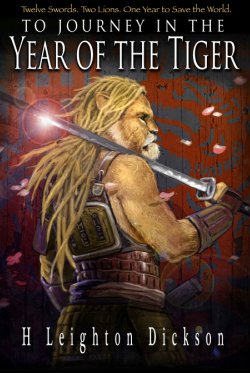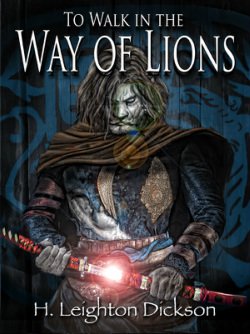Review: 'Tails from the Upper Kingdom', by H. Leighton Dickson

It was hard to believe that a man could see twenty-three winters before he began to live. It is harder even to believe that his life began all at once, on one night, with the occurring of three obscure and apparently random things; the death of a bird, the flash of golden eyes and the first of One Hundred Steps. But for Kirin Wynegarde-Grey, it did happen, just this way. His life began, as all great and terrible things do, in the Year of the Tiger. (p. 1)
And that, boys and girls, is how to begin a novel!
It is the reader’s option whether to take Dickson’s Tails from the Upper Kingdom series, of which these are Books 1 and 2, as science-fiction, set about 5,000 years in the future, or as high fantasy.
This is a powerful, post-apocalyptic story of lions and tigers, wolves and dragons, embracing and blending the cultures of Dynastic China, Ancient India and Feudal Japan. Half feline, half human, this genetically altered world has evolved in the wake of the fall of human civilization. (blurb)
Kirin Wynegarde-Grey is a genetic lion-man, and there are plenty of other half-feline men and women – leopards, tigers, ocelots, cheetahs, jaguars, lynx -- in these two books to please the reader.
“To Journey in the Year of the Tiger”, by H. Leighton Dickson. North Charleston, SC, CreateSpace, September 2012, trade paperback $14.99 (i + 343 pages), Kindle $2.99. 2nd printing, May 2013.
“To Walk in the Way of Lions”, by H. Leighton Dickson. North Charleston, SC, CreateSpace, October 2012, trade paperback $14.99 (i + 347 pages), Kindle $2.99. 2nd printing, May 2013.
Yes, the genetic blend includes tails.
His boots echoed as he trotted down a winding staircase made of polished teak, raising his tail slightly so that the tuft would not sweep the wooden steps. They had servants for that sort of thing and he despised getting dirty, even if it was only his tail. Soon, he was in the Hall of Warriors. (p. 3)
The lion-man’s romantic interest is a tiger-woman:
The face in the glass was that of a tigress, not yet having reached her 18th summer, with a slim, graceful build atypical of her Race. Her pelt was tawny-orange, her arms, legs, back and tail banded with black. Splashes of white accentuated her long throat, curved ears, and bright, wide eyes. Rings of kohl exaggerated her lashes and arched over her brows to create a perpetual expression of wonder. The stripes ran off her forehead like a river delta, her mane from her face like a waterfall. It cascaded to her shoulders only to curl upwards on itself once there, and each strand of hair was tipped in snowy white. Her mouth was small but generous, frequently contorted into a variety of smirks and smiles, pouts and frowns, for she was both a creature of sunlight and a creature of stars.
She stared at that face in the window glass.
What had her mother always said?
‘But Fallon, dear, you have such nice markings…’ She yawned, stretched, blew a stray lock of hair from her face. ‘Yep. Right up there with Good Family and Great Personality…’ (p. 10)
Kirin is the Captain of the Empress’ personal guard. While the rest of the great Palace is preparing the celebrations to mark the turning of the Year of the Ox into the Year of the Tiger, he is assigned to leave on a long mission with four others (and several guardsmen). The Upper Kingdom is guided by a Council of Seven, revered Seers whose visions have infallibly led the Empire in wisdom and peace for centuries. Now something, or someone, is killing the Seers, one by one, by unknown means, always in their beds at the close of the Second Watch of the night.
‘You four,’ bids the Empress, ‘with the addition of Kerris Wynegarde-Grey, will journey to Sha’Hadin, to discover who or what is killing my Seers. You will use any, and all, means at your disposal, all of your venerable skills to see that it is stopped, and stopped soon. Without the Gifts of Farsight and Vision, Pol’Lhasa, DharamShallah, and all of the Upper Kingdom will be vulnerable, and once vulnerable, shall surely fall.’ (p. 21)
The four are Kirin Wynegarde-Grey (lion), the Captain of her guard; his adjutant Major Ursa Laenskaya (female, snow leopard), an obsessed militant (Kerris to Kirin: “‘Ah Ursa, my flower, my love. Has she killed anyone lately?’” --p. 26); Fallon Waterford (the aforementioned tigress), the Empire’s Scholar, very knowledgeable but very young and naïve; and Sherah al Shiva (cheetah), the Empire’s Alchemist, an older femme fatale of complex personality, a dubious reliability, and an unguessable personal agenda. Kerris, Kirin’s twin but silver-grey where Kirin is golden, is the Empire’s Geomancer; a talented Geomancer, for all that he seems to be an unreliable drunken ladies’ man.
Their goal is Sha’Hadin, the mountainous monastery that is the home of the Council of Seven.
The trip should take ten hours at a steady trot, in time to make Sha’Hadin before the Second Watch. […] Kirin ground his teeth, unable to shake the feeling that this trip would not end in ten hours, nor the answers found within the cliffs of Sha’Hadin. This was going to take much, much longer. (p. 28)
Oh, boy, does it! The party meets high suspense before it even reaches Sha’Hadin:
This was the perfect place for an ambush, Kerris agreed silently. The mountain rose up steeply on one side, and the narrow ledge that had been their trail now flattened out, in a wide, almost level plateau. Below them, the gradient was less sharp, but deadly still, for to start a fall would surely see it to its stony end. Giant rocks dotted this section of trail like spikes on the back of a sleeping dragon. The mountains were full of such stories, of creatures much larger than cats, and to his credit Kerris believed them. He had seen too much not to.
He scanned those giant stones with narrowed eyes.
He heard the moan of hollow wind, the drum of Imperial hooves fading away.
He studied the elderly man, who suddenly seemed not nearly so desperate for help, nor nearly as elderly, as he too watched the trio attempting to pick their way around the cart and get to wider ground.
Make your move, old man, thought Kerris, his heart thudding in his throat. All three of them are completely defenseless. Now is the time!
As if reading those very thoughts, the jaguar turned back, fixing the grey lion with a glare that could freeze his blood. There was a flash and something metallic slid out from a sleeve. (p. 40)
 We are only forty pages into the first 343-page volume, with the second 347-page volume to come because To Journey in the Year of the Tiger leaves the adventurers (there are six, now) halfway around the world. To quote the blurb from To Walk in the Way of Lions,
We are only forty pages into the first 343-page volume, with the second 347-page volume to come because To Journey in the Year of the Tiger leaves the adventurers (there are six, now) halfway around the world. To quote the blurb from To Walk in the Way of Lions,
[It] picks up where ‘Journey’ leaves off, in the harsh deserts of Khanisthan. The team is running under a very set of different dynamics than before, for not only will they be forced to confront enemies tracking from the North and a hostile force from the Palace following from the South, but they must face their own demons that are plaguing them from within. It's man against man, cat against cat, Seer against Alchemist, […] From the ruthless wilds of Khanisthan to the wind-swept shores of the Mediterranean Sea, the beauty and savagery of the Upper Kingdom unfolds like a living thing before them as they travel. And soon, against all reason, they take the first steps beyond the Empire’s borders into the realm of the Ancestors, of carnivorous horses, of Dogs, Bear and Rats, and Kirin Wynegarde-Grey will find out what it means to follow the code of Bushido to the gates of death and beyond…
These two volumes – really a single novel – are the first in Dickson’s Tails from the Upper Kingdom series. She already has an excerpt from her in-progress next in the series, Songs from the Year of the Cat.
Dickson’s writing is not perfect. Her melodrama is sometimes over-the-top. She makes the adolescent Fallon Waterford too much the brainless ditz at the beginning, to allow for her character development into a more realistic adult through the course of the adventure; and Fallon’s slangy babble is too far removed from the formal speech of the other characters to be convincing. Also, the proofreading could be improved. There are too many examples of ‘it’s’ for ‘its’; missing initial quotation marks at the beginning of dialogue; and missing words; e.g., “‘I much to think about.’” (p. 157) But there is a wonder and a glory, and many surprises, that rises above all the little flaws in her epic saga. Believe me; you do not want to miss this!
These are self-published books via CreateSpace. Dickson says on her website that they have been submitted for “real publication” to Sofawolf Press. Don’t wait to see if Sofawolf accepts them; read them now!
One of the advantages of print-on-demand books is that the author can make changes between printings. The books currently being sold are the second printing. I do not know whether there are any changes in the text (they still need a better proofreading), but the covers designed by John Connell and Dickson herself have been slightly modified.
Read more: Fred Patten's review of Songs in the Year of the Cat - Roz Gibson's review of all three books
About the author
Fred Patten — read stories — contact (login required)a retired former librarian from North Hollywood, California, interested in general anthropomorphics
Comments
Post new comment